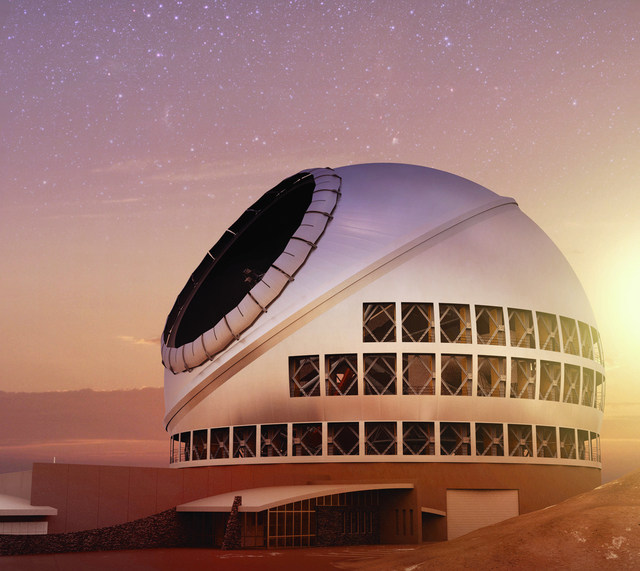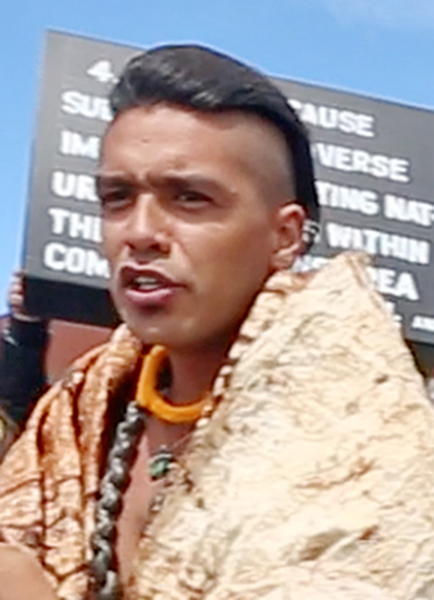If common ground was found during a talk story session Tuesday evening on the Thirty Meter Telescope, it’s that Native Hawaiian cultural practitioners and astronomers can both view Mauna Kea as a source of knowledge.
If common ground was found during a talk story session Tuesday evening on the Thirty Meter Telescope, it’s that Native Hawaiian cultural practitioners and astronomers can both view Mauna Kea as a source of knowledge.
But regarding how the mountain should be used, speakers at the event were light years apart.
The event at Laupahoehoe Community Public Charter School was the first in a series of events dubbed “TMT and Mauna Kea: Common Ground,” organized by the Hilo-Hamakua Community Development Corporation. About 100 attended.
Its two main speakers talked about the cultural significance of the mountain and the science behind the TMT.
Representing the cultural side, Lanakila Mangauil, a Hawaiian studies teacher and one of the leaders of the TMT protests, talked about Mauna Kea’s sacred status and why, for ecological and spiritual reasons, he said people were once largely forbidden from accessing the summit, now home to more than a dozen telescopes.
Mangauil argued the mountain is the source of water for a large area of Hawaii Island, and he sees the fight against the $1.4 billion telescope as being about respect for the environment.
“If I am going to live in the shadow of this mountain, if I am going to drink the water of this aina, then I have the responsibility to take care of these resources,” Mangauil said to applause.
Paul Coleman, an astrophysicist at the University of Hawaii’s Institute for Astronomy, spoke of what TMT will accomplish if it’s built on Mauna Kea.
Currently, construction is paused following protests on the mountain that led to 31 arrests April 2.
Coleman, who is part Hawaiian, said he was there to explain the science but not argue for or against TMT’s placement on the mountain. That, he said, was up to the audience to decide.
But, nonetheless, he appeared excited about the possibilities.
According to Coleman, the TMT will be able to study the entire viewable universe, which no existing telescope, on ground or in space, can accomplish.
“I get to look at my ancestors in a serious way,” he said, after explaining his family line can be traced to relatives of King David Kalakaua, whose lineage was connected to the start of the universe through a creation chant.
Coleman said TMT will have a resolution 10 to 12 times better than the Hubble space telescope and five to six times better than the James Webb Space Telescope, which is under development.
He said it will be the largest telescope in the northern hemisphere; a 39-meter telescope is being built in Chile.
But Coleman said the TMT is needed to study parts of the universe that can only be seen in the northern hemisphere.
Mangauil, who called TMT supporters infidels while interrupting a groundbreaking ceremony for the telescope last October, said being against the TMT or other telescopes on Mauna Kea isn’t anti-science, and he noted that observations of nature were interwoven into the Hawaiian religion.
He referenced the story of the first human being created from a union between Hoohokukalani (star mother) and Wakea (sky father), which he said explained how people are made from star dust.
“The human line comes from the star mother, so don’t tell us we didn’t know this,” Mangauil said.
He said the religion and its stories of gods and goddesses also explain humanity’s dependence on nature and how to live in balance with it. The kapu on ascending the summit of Mauna Kea, which is seen as a child of Wakea and Papahanaumoku (earth mother), was meant to protect sensitive areas, Mangauil said.
“Whatever gives life is an akua,” he said. “So that’s why the mountain is sacred. That’s where akua dwell. That’s where the elements that bring us life dwell.”
Mangauil was asked by an audience member whether people should play in the snow on the mountain if it’s sacred land.
He said that is a “symptom of not knowing the culture” and is “something we need to look at.”
“As a kid, we played in the snow,” Mangauil said. “Does that mean it is pono? No. But neither is bulldozing the mountain either. But we are learning.”
Coleman said TMT also will help astronomers find out whether there is life on other worlds, and study dark energy, dark matter, black holes, and the earliest stars and galaxies.
“We’re all made from star stuff as we know from Hawaiian traditions and our own scientific traditions,” he said. “Where did that come from? This is what we can see with the TMT.”
An audience member asked Coleman, “What does decolonized science look like?”
“That’s simple,” he responded. “Instead of spending time fighting it, join it.
“Grab every kid you know who is interested in science and make him an astronomer. In 10 years, we can take over astronomy on the islands.”
Coleman added to applause, “If you want to decolonize it, take it over.”
Here’s a list of the remaining events and speakers:
Wednesday, May 27
6:30-9 p.m.
Location: Kulaimano Community Center, Pepe‘ekeo
Speakers: Paul Neves – cultural and historical perspective; Sandra Dawson – Thirty Meter Telescope process; Peter Adler – sacred spaces.
Tuesday, June 2
6:30-9 p.m.
Location: Laupahoehoe Community Public Charter School Cafeteria
Speakers: Hualalai Keohuloa — cultural perspective; Wallace Ishibashi — security and safety at cultural sites; Paul Brewbaker — economy.
Tuesday, June 9 6:30-9 p.m.
Location: Laupahoehoe Community Public Charter School Cafeteria
Speakers: Richard Ha — Hawaii Island’s future; Art Kimura — robotics; Jesse Eiben — entomologist; Doug Simons — observatory science.
Email Tom Callis at tcallis@hawaiitribune-herald.com.


